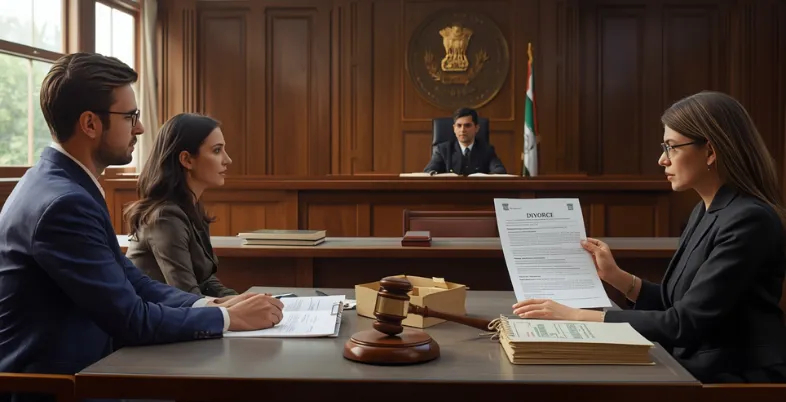The legal process of divorce in India is governed by a combination of personal laws based on religion, civil legislations, and the newly introduced provisions of the Bharatiya Nyaya Sanhita (BNS). Unlike a uniform system, each community—Hindus, Muslims, Christians, Parsis, and couples married under the Special Marriage Act—follows its own framework for marriage dissolution. This makes divorce in India both complex and deeply tied to cultural as well as legal traditions.
Over the years, changing social dynamics and judicial reforms have reshaped how divorce is understood and practiced. In metropolitan cities such as Delhi, Mumbai, and Bangalore, family courts have reported a steady rise in mutual consent divorces, even though contested cases remain more prevalent. Protective statutes like the Muslim Women (Protection of Rights on Divorce) Act, 1986 and new provisions under the Bharatiya Nyaya Sanhita ensure that issues such as cruelty, harassment, and maintenance are addressed within the legal system.
Because divorce involves overlapping civil and criminal aspects, it is more than just a personal separation—it is a legal journey that can affect rights, responsibilities, and future entitlements. Gaining clarity on the applicable laws, grounds for divorce, and court procedures is crucial for anyone preparing to navigate this path.
Legal Foundations: What Laws Apply
Divorce is governed by laws depending on a religion and law as preferred by the specific marital union. Here are the primary ones:
| Religion / Personal Law | Governing Divorce Law | Key Statutes or Acts |
| Hindus, Buddhists, Jains, Sikhs | Hindu Marriage Act, 1955 | HMA can offer such grounds as cruelty, desertion, adultery, conversion etc. |
| Christians | Indian Divorce Act, 1869 | It is the petition of Christian courts and Family courts. |
| Muslims | Muslim Personal Law / Dissolution of Muslim Marriages Act, 1939; Muslim Women (Protection of Rights on Divorce) Act, 1986 | These laws include extrajudicial and judicial divorce, maintenance etc. |
| Parsis | Parsi Marriage and Divorce Act, 1936 | Regulates marriage, divorce, alimony etc. |
| Interfaith / Civil marriages | Special Marriage Act, 1954 | Individuals who got married in this Act adhere to the marriage divorce regulations. |
BNS applies since July 1, 2024, to the crimes connected with the violation of rules in marriage (e.g. cruelty, dowry harassment), instead of various old IPCs. Harassment, cruelty etc., which is being cited during divorce can also serve under criminal charges within BNS.
Grounds / Types of Divorce

The legal process of divorce in India varies depending on the personal laws applicable to the couple and whether the divorce is by mutual consent or contested. Knowing the types and grounds helps spouses understand their rights and the appropriate legal steps.
Mutual Consent Divorce
This occurs when both spouses agree to end the marriage amicably. Key aspects include:
- Filing a joint petition in court.
- Living separately for a prescribed period (commonly one year under the Hindu Marriage Act).
- Settling matters like custody, maintenance, and property division.
- Courts may impose a waiting period, which can sometimes be waived if reconciliation is impossible.
Contested Divorce
A contested divorce arises when one spouse files the petition and the other disagrees or objects. Key aspects include:
- Filing based on specific grounds such as cruelty, desertion, adultery, or irretrievable breakdown of marriage.
- Courts examine witness testimonies, evidence, and cross-examinations.
- Contested divorces typically take longer to resolve due to detailed legal procedures.
Common Legal Grounds
- Cruelty: Physical, mental, or emotional harm. Under the BNS, this also includes harassment related to dowry and actions likely to cause severe injury or suicidal tendencies.
- Desertion: Abandonment for a continuous period, usually two years or more.
- Adultery: No longer a criminal offence following Supreme Court rulings, but can still serve as grounds for divorce.
- Irretrievable Breakdown: Considered in some cases when the marriage cannot be repaired, though it is not explicitly codified under all personal laws.
Understanding these grounds and types is essential for anyone navigating the legal process of divorce in India, as it helps prepare documentation, evidence, and legal strategy for a smoother resolution.
Recent Reforms & BNS Impacts
The Bharatiya Nyaya Sanhita (BNS), effective from July 1, 2024, has introduced important changes in how marital offences are addressed, including cruelty, harassment, and dowry-related issues. These reforms aim to modernize the legal framework and provide better protection to individuals in matrimonial disputes.
Redefinition of Cruelty
- Section 85 addresses cruelty by a spouse or relatives, covering both physical and mental abuse, as well as harassment related to dowry.
- Section 86 further expands the definition to include actions likely to cause severe injury or push a spouse toward suicide, ensuring comprehensive protection.
Dowry-Related Offences
- Section 80 deals with dowry deaths, prescribing strict punishments for cases where cruelty or harassment linked to dowry leads to the death of a spouse within seven years of marriage.
Prohibition of Remarriage Before Divorce
- Section 82 criminalizes marrying again before legally dissolving a previous marriage, preventing unlawful remarriages during ongoing divorce proceedings.
Such penalty mechanisms can also influence the legal process of divorce in India in cases of cruelty, harassment, or unlawful remarriage, as the courts may treat such actions as a serious offence.
Suggested Read: Lawyers in India
Step-by-Step Legal Process of Divorce in India

The legal process of divorce involves a series of steps that vary depending on whether the divorce is by mutual consent or contested, as well as the personal law governing the marriage. Understanding these steps can help couples navigate the process efficiently.
1. Early Preparations / Talking things Over
- Locate qualified attorneys in areas of family law.
- Gathering of documents: marriage certificate, proof of address, income, property documents, evidence of separation (where applicable), evidence of cruelty, desertion etc.
- Find out which law or act of your own is in force.
2. Filing the Petition
- Mutual consent For joint petition: under corresponding act.
- Contested: One party reaches out through petitioning reasons.
- Under special law such as Hindu marriage act, Special marriage act etc.
3. Notice / Summons
- Notice is given to the other spouse and opportunity granted to respond.
- Occasionally counter-affidavit obtained.
4. Cooling Period/Waiting Period.
- In mutual consent, a waiting period (usually 6 months in section 13B Hindu marriage Act). The courts can forego this under exceptional circumstances when the reconciliation is not possible.
- Paperwork to do, may be mediation.
5. Evidence / Pleadings in Silvers confronted case
- Fact and witness testimonies, medical details.
- In case of extreme brutality or harassment claims, the evidence evidenced on the basis of BNS Sections (85, 86) can be brought before criminal proceedings or simultaneously.
6. Mediation or you Counseling (Court-Directed)
Many family courts encourage or mandate mediation to attempt reconciliation or resolve disputes related to child custody, maintenance, or property.
7. Final Hearing and Decree
- Mutual Consent: If the court is satisfied with the petition, a divorce decree is issued.
- Contested Divorce: After hearings, cross-examinations, and submissions, the court delivers its final judgment and grants or denies the divorce.
8. Post-Decree Matters
- Child Custody: Courts decide custody and visitation rights.
- Maintenance / Alimony: Spouses may be granted financial support.
- Property Division: Assets are divided according to personal law and court orders.
Role of BNS Criminal Provisions in Divorce Context
The Bharatiya Nyaya Sanhita (BNS), effective from July 1, 2024, plays an important role in divorce cases where allegations of cruelty, harassment, or unlawful remarriage are involved. These criminal provisions complement civil divorce laws and ensure that serious marital misconduct is addressed appropriately.
- 545 Unjustifiable cruelty by husband or relatives. A divorce petition can be reinforced on allegations under this. (Apni Law)
- In section 86 BNS: Cruelty, there is the definition of cruelty. Explains what sorts of behaviour should be cruel. (Apni Law)
- BNS 82: Dis remarriage in lifetime of wife or husband. In case a person remarries prior to the permission of divorce, it can be compared to penalty crime. (Prashant Kanha)
- Other parts (e.g. dowry death, dowry harassment) of BNS could prove applicable in context of the divorce when there is abuse or/and it is being forced; e.g. of dowry death Section 80 BNS dowry death. (Apni Law)
Common Mistakes & Key Considerations
Navigating the legal process of divorce in India can be complex, and several common mistakes can delay proceedings or affect outcomes. Being aware of these issues helps ensure a smoother and more effective process.
Common Mistakes:
- Ignoring Applicable Personal Law – Some couples fail to determine which law (Hindu Marriage Act, Special Marriage Act, etc.) governs their divorce, which can cause legal complications.
- Insufficient Evidence – Lack of proper documentation or proof for grounds such as cruelty, desertion, or harassment can weaken a case.
- Delayed Filing – Waiting too long to file a divorce petition may conflict with statutory limitations and prolong the legal process.
- Overlooking Maintenance or Alimony – Failing to address financial support obligations can lead to disputes post-divorce.
- Remarriage Before Decree – Attempting to remarry before the divorce is legally finalized can create legal difficulties under BNS Section 82.
Key Considerations:
- Gather all necessary documents, including proof of marriage, separation, and any evidence supporting claims.
- Understand the applicable law and grounds for divorce.
- Seek guidance from an experienced family law attorney to navigate civil and criminal implications.
- Consider mediation or counseling where required to resolve disputes amicably.
Also Read: Top Female Lawyers in India
Landmark judgments & precedents to know
Several landmark judgments by the Supreme Court and High Courts have shaped the legal process of divorce in India, influencing how courts interpret grounds, procedures, and rights. Being aware of these precedents helps individuals and legal practitioners navigate divorce cases more effectively.
Key Cases:
Amardeep Singh v. Harveen Kaur (2017)
- The Supreme Court allowed the waiver of the waiting period in mutual consent divorce in exceptional circumstances where reconciliation was not possible.
- This judgment helped speed up mutual consent divorces in cases with no chance of reconciliation.
Joseph Shine v. Union of India (2018)
- The Supreme Court decriminalized adultery, ruling that adultery is no longer a criminal offence under Indian law.
- Although not a criminal offence, adultery can still be cited as a ground for divorce under personal laws.
Custody, Property Division, and Maintenance Cases
- Various High Court judgments have clarified rights related to child custody, maintenance, alimony, and property division.
- Courts consistently emphasize the best interests of the child and fair financial settlements between spouses.
Importance of Landmark Judgments
- They clarify the interpretation of personal and civil laws in divorce cases.
- Help lawyers and spouses understand how courts apply the law in specific circumstances.
- Serve as guidance for drafting petitions, presenting evidence, and arguing cases effectively.
Conclusion
Divorce in India involves a complex interplay of personal laws, civil procedures, and, in some cases, criminal provisions under the Bharatiya Nyaya Sanhita (BNS). Couples must carefully manage each stage, from understanding applicable laws and gathering evidence to resolving issues of child custody, maintenance, and property division.
Recent reforms and landmark judgments have enhanced protections for spouses, particularly in cases of cruelty, harassment, or unlawful remarriage. Avoiding common mistakes, such as delayed filing or inadequate documentation, and seeking guidance from experienced legal counsel can make the process smoother.
Being aware of personal laws, procedural requirements, and court expectations empowers individuals to safeguard their rights. A clear understanding of the legal process of divorce in India ensures fair outcomes and helps couples resolve disputes efficiently while protecting their legal and personal interests.
FAQs
1. Is it possible not to prove fault in order to get a divorce according to the existing Indian law?
Yes, a mutual consent divorce makes you not require fault. Nevertheless, the contested divorces need reasons such as cruelty, desertion etc.
2. Hindu marriage act Waiting period of a mutual consent divorce?
Traditionally six months. It can be omitted by the court in extreme circumstances when there can be no reconciliation.
3. What is now included in cruelty to ground divorce?
Both physical and mental inhumanity. In Section 86, changed under BNS to cover harassment, dowry claims and acts that will most probably lead to suicide or serious injury. (Apni Law)
4. Is adultery considered a crime according to the new BNS?
No, whereas currently adultery is not a criminal offense, however, according to personal law, it is a major cause of divorce. In a case known as Joseph Shine vs. Union of India (2018), headquartered by the Supreme Court, adultery was ruled unconstitutional as a criminal offense.
5. The question is, what are the divorce laws protecting Muslim women?
Muslim Women (Protection of Rights on Divorce) Act, 1986 provides right to maintenance and reasonable provision in post divorce. Muslim Marriages Act, 1939 gives a permission to separation by the court.





